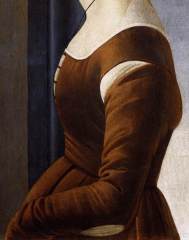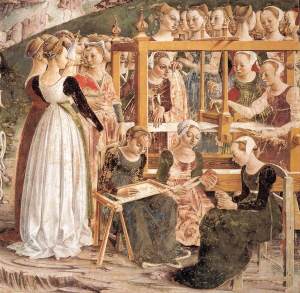I created this documentation last year for open A&S faires, thought I’d post it here as well.
The gamurra is a women’s dress, usually laced up the front, with a well fitted bodice and an attached skirt. By the last quarter of the century detachable (and thereby interchangeable) sleeves are seen, sometimes in a different fabric. Popular fabrics were wool and silk, and could be solid colors or elaborately patterned. Contemporary accounts describe elaborate embroidery with pearls and other decoration (Herald).

Allegory of September, Cosmè Tura, 1476-84, Palazzo Schifanoia, Ferrara
I choose a light weight linen for this gamurra to stay cool in the summer. The bodice is four pieces, with a mostly straight front opening. An earlier version had a curved front opening that did not work well when corded. Skirt panels are square and the bodice to skirt hem width ratio is approximately 1:6. This gives the needed volume to the skirt to match period artwork. A 1:4 ratio would work for heavier fabric with a stiffer drape.

Allegory of April, Triumph of Venus , 1476-84, Palazzo Schifanoia, Ferrara

Allegory of April, Triumph of Venus , 1476-84, Palazzo Schifanoia, Ferrara
Box pleats appear in some artwork for Florence and Ferrara. I used stacked boxpleats to gather the large volume of fabric into the body. This dress was my first attempt with box pleats. The inner pleats show more than I wanted, so the next dress I made I recessed the inner stacked pleats, which hides them very well, but still gives the needed volume.
The hem contains strips of felted wool (as seen in the Eleonora of Toldeo burial gown) which give the hem volume (no underskirt is needed).
The bodice has an inner piece with 2 layers of light weight linen sewn in channels to hold narrow diameter hemp cording. I used more cords per channel in the front than the back. This gives the necessary support to achieve the correct bustline. I have been unable to find extant examples or contemporary discussions of this technique, but after reviewing Jen Thompson’s experiments of corded vs non-corded bodice stiffening I decided to go with cording. I can’t document the materials, but I can definitely document the look.
I made lucet lacing from heavy cotton embroidery floss. The skirt uses hook and eye to close instead of lacing. The hooks allow for a tight join of the fabric that won’t shift and it doesn’t pucker. The skirt is split a few inches below the waist to provide enough room to pull the tight fitting bodice over my shoulders.

Birth of St John the Baptist, Domenico Ghirlandaio, 1486-90 Cappella Tornabuoni, Santa Maria Novella, Florence

Portrait of Giovanna Tornabuoni, Domenico Ghirlandaio, 1488 Museo Thyssen-Bornemisza, Madrid
Lacing holes for the front opening are reinforced with a metal ring (evidence in 16th C Italian burial clothes suggest their use as reinforcement) and covered with cotton embroidery floss. Sleeve attachment rings are hidden, I have not found evidence for the hole going through the shoulder.
The front lacing is looped twice through each hole. This gives additional friction and prevents the lace from slipping, which allows for a tighter fit under the bust and a looser fit above. It is much more comfortable to wear than my two-side lacing dresses and the silhouette looks more accurate.

Allegory of April, Triumph of Venus , 1476-84, Palazzo Schifanoia, Ferrara
GAMURRA/CAMMURA/CAMORA (F). The Tuscan term for the simple dress worn directly over the woman’s chemise (camicia). In the north of Italy, it is known by the terms zupa, zipa or socha. The gamurra is worn by women of all classes. It is both functional and informal, being worn on its own at home, and covered by some form of overgarment such as the cioppa, mantello, pellanda or vestimento out-of-doors or on a more formal occasion. Following the contour of the body, it is usually unlined, and made of wool or occasionally silk. Earlier in the century, the sleeves are attached; but later they are more commonly separate, and often of a different, richer textile. (Herald)
Herald, J. (1981). Renaissance dress in Italy 1400-1500. The History of dress series, 2. London: Bell & Hyman.






Pingback: 1480s Italian Giornea Overdress | Sew 4 Cons
Pingback: Hand-sewn eyelets « Dawn's Dress Diary